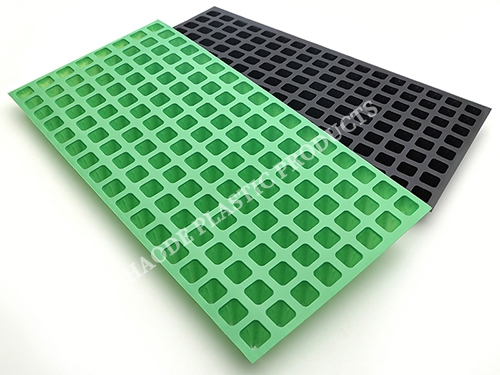Methods of Using Seedling Trays to Improve Seed Germination Rate
2024-06-20 09:08:10
Outline
1. Choose the Suitable Seedling Tray
2. Prepare High-quality Substrate
3. Conduct Seed Treatment
4. Correct Sowing Method
5. Management during the Germination Period
6. Management during the Seedling Period
7. Conclusion

In home gardening and agricultural production, seedling trays are important tools for improving seed germination rates and seedling survival rates. Correct use of seedling trays can provide an ideal germination environment for seeds, thereby significantly improving the germination rate. This article will introduce the methods of using seedling trays to improve the seed germination rate to help you achieve efficient seedling raising.
1. Choose the Suitable Seedling Tray
Choosing the appropriate seedling tray is the first step to improve the germination rate. There are various materials and specifications of seedling trays on the market, and the selection should be based on the size of the seeds and planting requirements.
Material: Common materials include plastic, foam and paper. Plastic seedling trays are highly durable and suitable for multiple uses; foam seedling trays are lightweight and have good heat preservation; paper seedling trays are environmentally friendly and have good air permeability.
Specification: Small-aperture seedling trays are suitable for small seeds, and large-aperture seedling trays are suitable for large seeds. Choosing the seedling tray with the appropriate aperture helps to provide sufficient growth space.
2. Prepare High-quality Substrate
The substrate is the key to seed germination, and choosing the appropriate substrate can significantly improve the germination rate.
Substrate type: Commonly used substrates include peat, coconut coir, perlite, etc. Peat is rich in organic matter, coconut coir has good air permeability, and perlite provides good drainage. They can be mixed and configured according to the needs of different crops.
Substrate disinfection: Disinfect the substrate before use to effectively prevent pathogen infection. Steam disinfection or high-temperature baking methods can be used.
3. Conduct Seed Treatment
Proper treatment of seeds before sowing can improve the germination rate.
Seed soaking: Soaking the seeds in warm water for several hours to overnight helps to soften the seed coat and promote the absorption of water and germination of the seeds.
Germination promotion treatment: Some seeds treated in a low-temperature or high-temperature environment for a period of time can break dormancy and improve the germination rate.
4. Correct Sowing Method
The sowing method is crucial for seed germination, and it is necessary to ensure that each seed can obtain a suitable environment.
Fill the substrate: Fill the substrate evenly into the seedling tray and slightly compact it, but do not be too tight to maintain good air permeability.
Even sowing: According to the size of the seeds, evenly sprinkle the seeds on the surface of the substrate or sow by holes. Small seeds can be directly broadcast, and large seeds are recommended to be sown by holes and covered with an appropriate amount of substrate.
Watering: Gently spray water mist after sowing to keep the substrate moist but not too wet to avoid seed rot.
5. Management during the Germination Period
During the seed germination period, it is necessary to maintain suitable environmental conditions to promote the smooth germination of seeds.
Moisture retention: Keep the substrate moist but not too wet. Fine mist spraying can be performed using a sprayer. Avoid water accumulation to prevent seed rot.
Temperature control: Most seeds germinate best at a temperature of 20-25°C. A seedling tray cover can be used to maintain the temperature or the seedling tray can be placed in a warm environment.
Light: Some seeds require light during the germination period, while some do not. Manage according to the needs of the seeds. If light is required, the seedling tray can be placed in a sunny place or supplemented with plant growth lights.
6. Management during the Seedling Period
After the seeds germinate, enter the management of the seedling period to ensure the healthy growth of the seedlings.
Sufficient light: Seedlings require sufficient light, and at least 12-16 hours of light time is required every day. Plant growth lights can be used to supplement the light.
Appropriate watering: Keep the substrate moist but not too wet to avoid root rot caused by water accumulation. Gradually reduce the watering frequency to promote root growth.
Fertilization management: After the seedlings grow two true leaves, appropriate fertilization can be started. Select diluted liquid fertilizers to avoid burning the seedlings due to excessive fertilizer concentration.
7. Conclusion
Using seedling trays is an effective method to improve the seed germination rate. By choosing the appropriate seedling trays, preparing high-quality substrates, conducting seed treatment, correct sowing and scientific management, the seed germination rate and seedling survival rate can be significantly improved. I hope the methods provided in this article can help you achieve efficient seedling raising and enjoy the joy of a bountiful harvest.
If you have any questions or experiences to share, you are welcome to contact us for communication. Let's explore efficient seedling raising methods together and create a healthy and lush plant world!

The CNC Seed Braiding Machine is a high-precision, fully automated agricultural equipment s...

It adopts electrical integration and can be started by pressing the fully automatic button ...

The XP750 seeder has stable performance, excellent product quality, simple and convenient o...

It adopts electrical integration and can be started by pressing the fully automatic button ...



